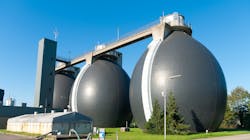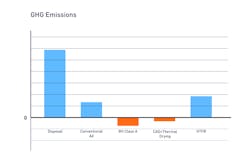An Economic & Sustainability Comparison of Sludge Management Upgrades
A study earlier this year by UN University’s Canadian-based Institute for Water, Environment and Health found that some 380 billion cubic meters of wastewater are annually produced worldwide and that the amount of wastewater generated is rising quickly, with a projected increase of roughly 24% by 2030 and 51% by 2050. The study went on to conclude that vast amounts of valuable energy, agricultural nutrients, and water could potentially be recovered from these future volumes.
In North America and elsewhere globally, a big part of the recovery equation centers on the management of sludge, the byproduct of wastewater treatment. Depending on the way it is viewed and ultimately managed, sludge can either be a significant cost burden and contributor to climate emissions or a valuable opportunity to reduce greenhouse gas (GHG) emissions while recovering energy, creating useful products, reducing disposal costs and landfill burdens, and generating new revenue streams.
Municipalities considering wastewater treatment upgrades for managing sludge more sustainably, can pursue several different routes and technology options. This article highlights the potential environmental and economic benefits of four separate sludge management strategies. By evaluating hypothetical use case examples in parallel against a baseline approach — with starting inputs consistent across all scenarios — the relative paybacks and sustainable value of each upgrade can be realistically compared. The goal is help inform a decision-making framework and provide a starting point to more detailed investigations.
The sludge management approaches evaluated include:
- A baseline approach that includes traditional wastewater treatment, sludge dewatering, and landfill disposal of 100% of produced sludge;
- Conventional anaerobic digestion (CAD);
- CAD with biological hydrolysis (BH);
- CAD with thermal drying; and
- Traditional wastewater treatment with sludge incineration.
To establish a standard comparison of different process upgrades, the evaluation assumes an average size wastewater treatment plant serving a mid-sized U.S. community, with a capacity of 25 million gallons per day (mgd) and 130,000 tons per year of wet sludge to be treated (Use Cases 1, 2, 3, and 4) or dewatered and disposed (baseline scenario).
Table 1, below, provides the full set of assumptions and calculations for a baseline scenario and the four sludge management approaches. The baseline use case assumes 32,500 tons per year of sludge is produced of which 100% is landfilled, resulting in disposal and trucking costs of $812,500 and $1,625,000 per year, respectively.
Capital expenses (CAPEX) are estimated at $1 million and operating expenses (OPEX) at $100,000 per year. Additionally, the baseline use case assumes 11,747 tons of equivalent CO2 GHG emissions per year would be released as a result of landfill emissions, burning of natural gas, electricity usage, and trucking.
Use Case 1: Conventional Anaerobic Digestion
Economic
With a projected CAPEX of $10,000,000 and an OPEX of $500,000 per year, CAD has significantly higher investment and operating costs over the baseline example. But those higher costs are also offset by cost reductions and the creation of a new revenue stream.
By incorporating CAD, the estimated yearly amount of produced sludge is lowered by 21.3% compared to the baseline example and results in the production of a Class B biosolid. Depending on the location and the prevailing regulations, land application of a Class B product may or may not be restricted. For the purposes of this comparison, it is assumed that biosolids can be land applied 50% of the time, thus reducing the overall disposal costs by 60% (at $319,618 per year) compared to the baseline example. Trucking costs (at $1,278,472) associated with hauling sludge and biosolids are $346,528 per year less compared to the baseline.
CAD technology offers plants the opportunity to recover biogas for beneficial reuse. As a renewable energy, biogas can be utilized in multiple ways. It can be used to power a boiler, run a turbine for generating electricity and heat, or the biogas can be upgraded to a renewable natural gas (RNG) and injected into a commercial natural gas pipeline for sale on the RNG market. However, for this study it is assumed that all produced biogas is utilized with a value of $15/MMBTU. Calculating 37,317 MMBTU/year of biogas is produced, the estimated biogas financial payback is $559,755 per year.
Factoring the full spectrum of financial considerations, the estimated payback period on investment for CAD compared to the baseline is three years.
Environmental
With 50% of produced sludge diverted from landfills, CAD significantly lowers GHG emissions from landfills. GHG emissions are still produced from burning of natural gas, producing biogas, electricity usage, and trucking of sludge and biosolids but are significantly reduced. Compared to the baseline case, total tons of equivalent CO2 GHG emissions per year are reduced by 75%.
Use Case 2: Conventional Anaerobic Digestion with Biological Hydrolysis (BH)
Integrated upstream of the CAD system, BH technology introduces a key optimization to the AD process by removing the rate limiting step from the digester. Compared to a 20- to 30-day hydraulic retention time (HRT) for conventional mesophilic digestion, the addition of BH lowers the HRT to 15 days, enhancing digester capacity, boosting biogas production and creating Class A biosolids. Importantly, this allows the municipality to more than double the sludge throughput of an existing digester system, municipalities can expand without adding a lot of additional infrastructure.
Economic
Including BH with CAD increases the projected CAPEX (up to $12,000,000) and OPEX (up to $650,000). The estimated amount of produced sludge is reduced by 21.6% compared to the baseline example, a slightly higher reduction than CAD alone. In addition to eliminating disposal costs by achieving Class A biosolid, BH combined with CAD results in trucking expenses of $1,273,324 per year, a slightly bigger reduction than CAD compared to the baseline.
With the BH enhancement, the estimated yearly amount of biogas production is nearly 15% higher compared to CAD in example 1, resulting in a greater RNG financial payback ($642,900 per year). Although more complex than CAD by itself, BH with CAD produces a Class A biosolid, offering more opportunities for beneficial reuse. The estimated payback period on investment for BH with CAD is four years compared to the baseline.
Environmental
By creating a Class A biosolid and achieving 100% diversion from landfills, BH combined with CAD completely eliminates GHG emissions from landfills, more than compensating for GHG emissions produced from other activities in this example. This produces the highest environmental value of all use cases.
Use Case 3: Conventional Anaerobic Digestion with Thermal Drying
Economic
Applying thermal drying technology combined with CAD requires a CAPEX ($15 million) and OPEX ($1.5 million) that is greater than the previous examples, but the volume reduction of produced sludge that is achieved is also significantly enhanced, with an estimated 60% decrease compared to the baseline.
Thermal drying with CAD eliminates disposal costs and, with substantially less sludge to manage, trucking expenses are lowered by $975,000 per year compared to the baseline example. Biogas production (37,317 MMBTU/year) is equal to that in example 1, generating the same estimated RNG financial payback ($559,755 per year). Slightly less than example 2 (BH + AD), combining thermal drying with CAD produces a Class A biosolid with opportunities for beneficial reuse. The estimated payback period on investment for BH with CAD is five years compared to the baseline.
Environmental
Similar to use case two, thermal drying combined with CAD creates a Class A biosolid, resulting in 100% diversion from landfills and completely eliminating landfill GHG emissions. This decrease more than compensates for GHG emissions produced from other activities in this example, producing an environmental benefit similar to that in use case two.
Use Case 4: High Temperature Fluid Bed Incineration
Economic
With high temperature fluid bed (HTFB) incineration, water content in sludge is evaporated and organic materials are combusted, reducing the dewatered sludge to less than 7% of its initial weight. HTFB achieves the largest sludge volume reduction of all examples, diverting 93% of the sludge from landfills and lowering disposal and trucking costs by $585,000 and $1,170,000, respectively, compared to the baseline.
However, with a CAPEX of $30 million and yearly OPEX of $3 million — and a 10-year investment payback period — HTFB is not economical compared to the other examples at this scale (the economics of incineration become more favorable at larger facilities).
Environmental
Compared to the baseline and all other use cases, HTFB requires the largest amount of electricity, resulting in the highest amount of equivalent CO2 tons of GHG emissions per year related to electrical use. But with 93% of sludge diverted from landfills compared to the baseline, HTFB overall reduces GHG emissions by 66% over the baseline case.
Conclusions
For an average size wastewater plant (25 mgd), use cases two (BH + CAD) and three (CAD + thermal drying) provide the greatest GHG reductions which in turn gives the highest environmental performance compared to the other cases. This is due to the ability of producing Class A biosolids that diverts 100% of sludge from landfills.
With sludge management, solutions that divert sludge waste from landfills are the most effective in terms of the climate-related benefits they provide, mostly from the elimination of methane emissions. When landfilled, sludge waste decomposes over time and produces both CO2 and methane. In terms of their global warming potential, the U.S. Environmental Protection Agency classifies methane as 25 times more potent than CO2. Therefore, digesting biosolids prior to landfill gives the greatest reduction in GHG emissions.
The use case examples also demonstrate that the strongest environmental cases can also be the most economical. Although BH and thermal drying enhancements require higher capital and operating costs, the investment payback is relatively quick, after which the financial benefits keep accumulating.
About the Author
Kristina Gerber
domain leader for anaerobic digestion at Veolia Water Technologies & Solutions
Kristina Gerber is the domain leader for anaerobic digestion at Veolia Water Technologies & Solutions. She has been in the wastewater and biosolids industry for more than 15 years with a B.S. in Chemical Engineering, M.S. in Engineering Management as well as being a Professional Engineer. Kristina started out as a pilot/lab tech with her career path extending to project engineering, project management, proposals manager and now technically supporting commercial teams. She is passionate about the environment, sustainability, and providing biosolids and wastewater solutions for clients.


